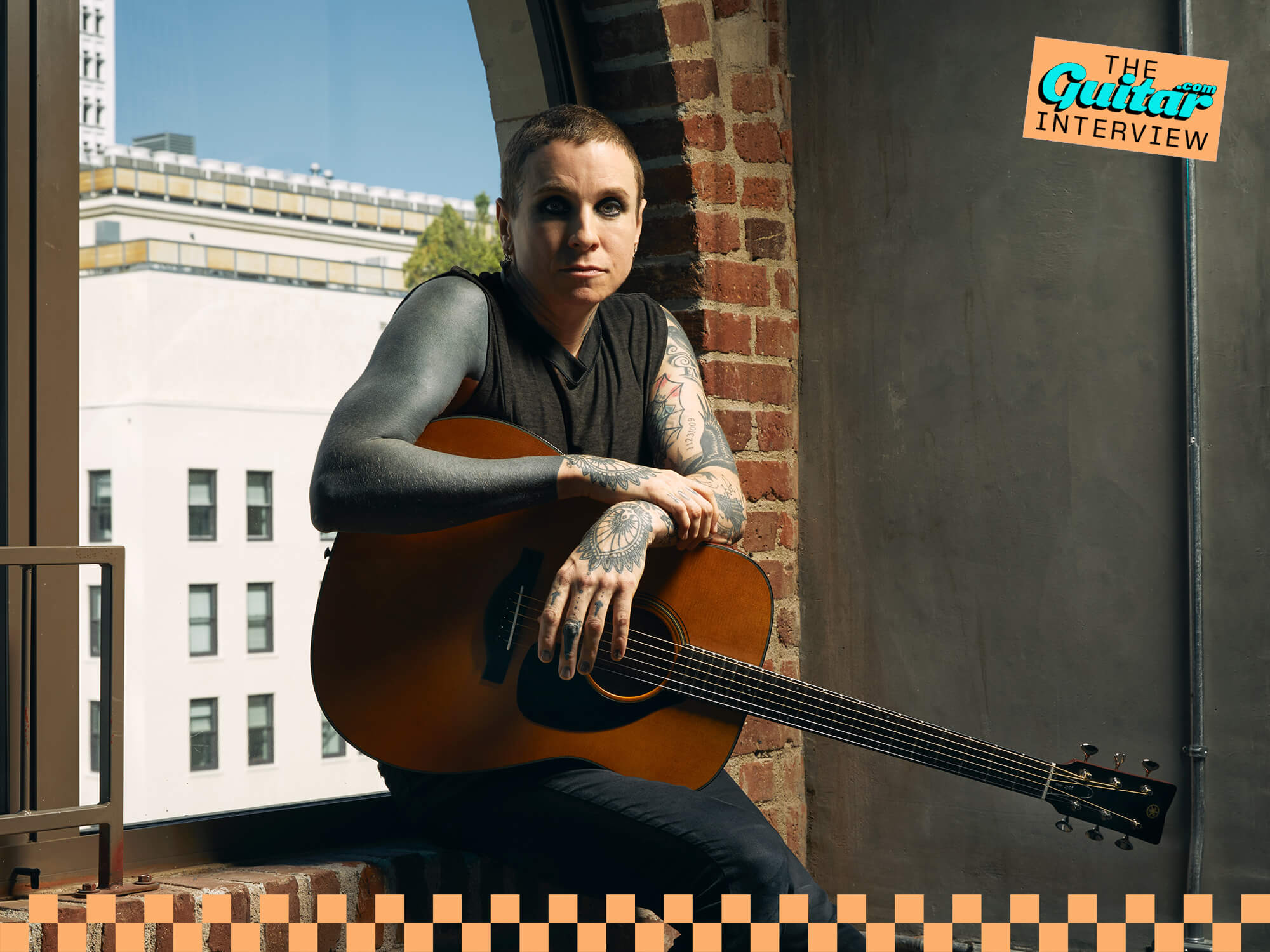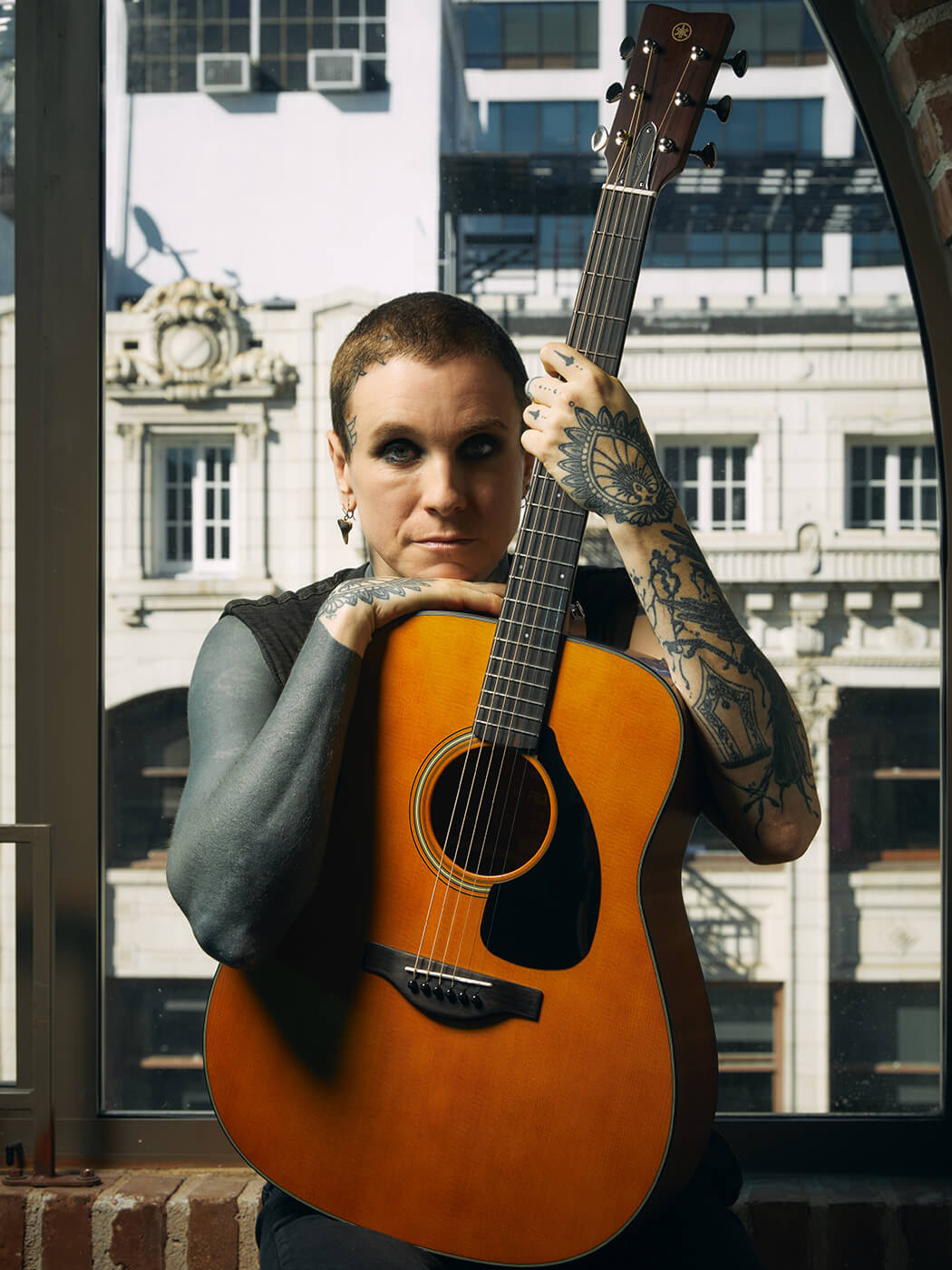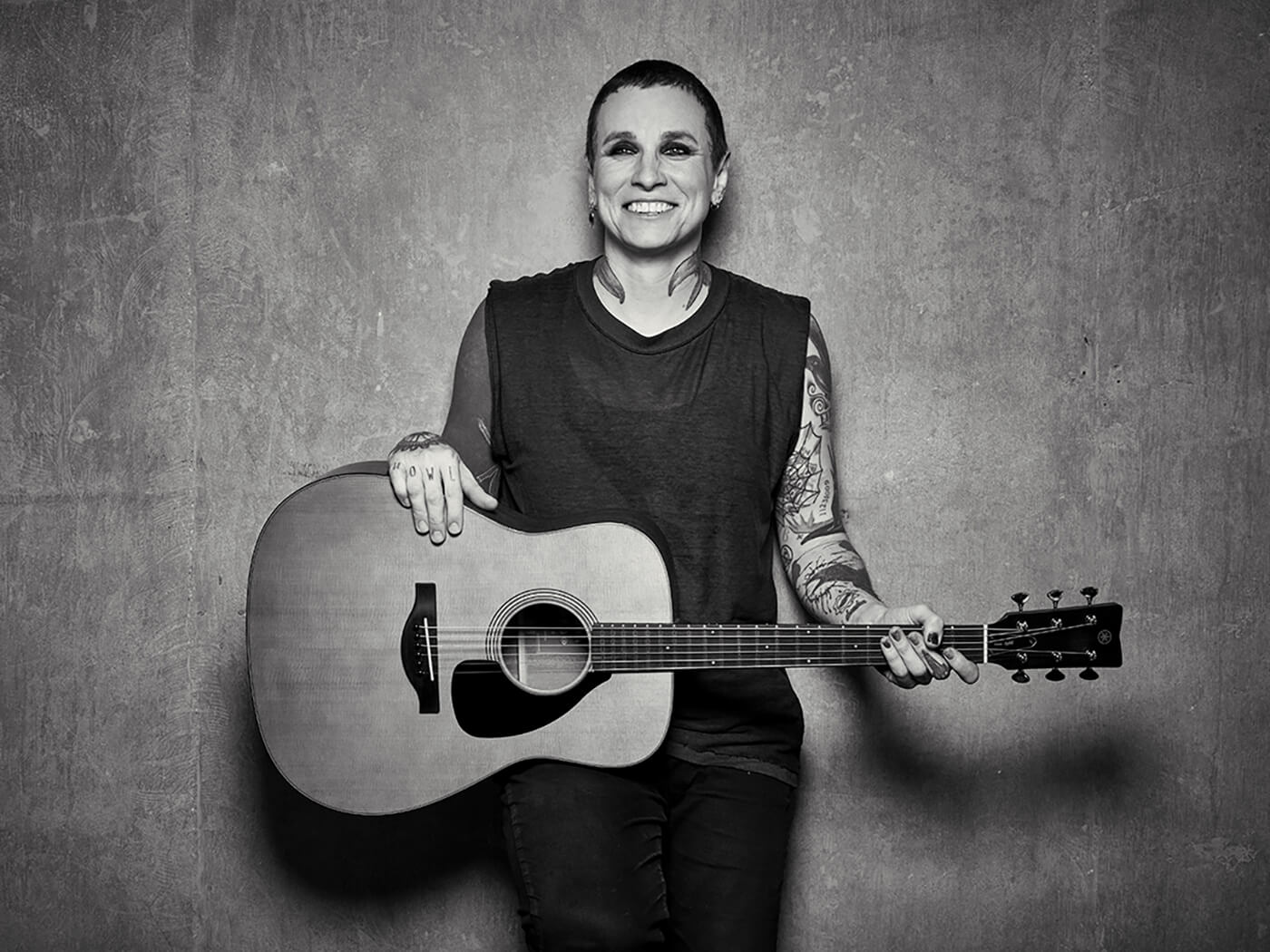Related Tags
Laura Jane Grace on the “true measure of a guitar’s worth” and her new solo album
The Against Me! bandleader and solo artist on recording with Steve Albini, the power of stripping down your instrumentation, and why she traded a $3,000 Martin for a broken $300 Takamine…

Laura Jane Grace. Image: Travis Shinn
The black lines begin at Laura Jane Grace’s feet and end on her head. For the past decade, the Japanese artists Gakkin and Kenji Alucky have been tattooing the erstwhile Against Me! leader, turning her body into a sprawling mesh of images that fuse nature and geometry. When Grace travelled to Gakkin’s new studio in Amsterdam two summers ago, their journey ended with roses coiled around a bird of prey, spreading out across her shaved skull. “At the end of the session, he gave me a guitar, beautifully hand painted in this swirling design,” Grace recalls during a Zoom call. “It solidified it for me, I think. It was like, ‘This is the end of me getting tattooed by you.’”
But the instrument – a humble Gretsch G2420 Streamliner that now lives at her rehearsal space in downtown Chicago – stopped being just a nice gesture almost immediately. Grace remains a little reluctant to play it lest she damages the artwork, but as soon as it was in her hands a song fell out of the thing. “I think that’s the true measure of a guitar’s worth,” she observes. “It’s not the price you bought it for, it’s how much work it can do. Can it give you songs?”
She pauses for a moment, settling on a thought she’s been coming back to since playing a holiday show with Lucero in Memphis during December of last year. “Back in 2008 I did the Revival Tour with Ben Nichols from Lucero,” she continues. “It’s very acoustic heavy. I had this $3,000 Martin. It sounded like shit. Ben was playing this $300 Takamine with a piece of rope for a strap. It looked and sounded better than anyone else’s guitars.
“So, drunkenly on the last night of the tour, I said I’d trade him this Martin for it, even though he’d smashed it and the fuckin’ back was hanging off. I wrote at least two records on that Takamine that I’m convinced I would not have if not for my connection to that shitty guitar. That’s worth infinitely more to me than the Martin.”

For The Birds
The Gretsch’s song is Birds Talk Too, a fidgety rocker appropriately pocked with Amsterdam ephemera, that acts as a sort of anchor for Grace’s enjoyably all-over-the-place new record Hole in My Head. Since placing Against Me! on a shelf in 2020 as the pandemic took hold – a recent Rolling Stone profile revealed that relationships within the punk institution are on the mend – Grace has released Stay Alive, a bare bones acoustic record made with Steve Albini, but this is something else.
Hole in My Head does a bunch of different things – Birds Talk Too is all call-and-response and riffs on George Harrison’s Got My Mind Set on You, and yet the title track sounds like the Marked Men – but it does each of them with a sort of breeziness that Grace might have shied away from in the past. A treatise on the loss of DIY spaces called Punk Rock in Basements is the LP’s most overt love letter to I, Jonathan-era Jonathan Richman, for example, but not its only one.
Interestingly, Grace identifies necessity as one of the key reasons behind its antic spirit. “That’s the DIY approach,” she says. “Be honest with yourself – what can you do right now? I didn’t have a drummer for this record, but I know how to write drum parts, I know how to use drum machines. It can be fun to make records that way. I love the Clash. But I also love Big Audio Dynamite.”
This feeling spreads out in the direction of acoustic highlights such as Dysphoria Hoodie and Cuffing Season, which are rendered in the plainest terms possible, without any concern for the palettes of the songs to either side of them. Studied and hopelessly melodic, they make for interesting points of comparison with the utilitarian rage that drove early Against Me!, where vein-bursting punk songs were rendered on wooden instruments because that was what was available.
A few decades on, Grace hasn’t lost her desire to present things as they are, even when other options are easily accessed. “I’m pushing against the want to have the instrumentation and the want to document what the record really is, which is that I’ve spent two years on the road touring as a solo artist,” Grace observes. “These are the songs I wrote while touring in that way – I’d play them every night just me and an acoustic guitar on stage. I want to represent that.”

Jumping In
Hole in My Head was recorded at Native Sound in St. Louis, Missouri alongside David Beeman, with the only musician on tape aside from Grace being Drive-By Truckers bassist Matt Patton. “I literally sent out a tweet on what used to be Twitter and he was like, ‘I’ll come and make a record with you’,” Grace recalls. “I had never met him before. But he jumps right into it and that’s the sound that comes out.”
As stripped back as this all appears, it’s pretty easygoing, even florid, compared to making Stay Alive. Necessarily so, perhaps, given the material. “Going into [Stay Alive] as a fan of Steve Albini, I knew what it would be like and, literally, if it took me more than two takes he was fucking annoyed,” Grace says. “He wanted to move on. It wasn’t necessarily that it’s how I like to make records, it was that I wanted to make a record with Steve Albini and I wanted to do it his way.
“With this record it was much more that I’d do the amount of takes that I wanted to, there was more leaning on some editing and ProTools, but still trying to do live takes. Some of it, with Matt, we were writing on the spot, so you need to be able to go back and forth. I feel like working with Steve was this weird graduation having made records with Butch Vig, where you’d sometimes do a thousand takes of a song.”
Grace’s acoustic in the studio was the same Yamaha LJ16 she has toured with for the past couple of years, with accents coming from the Gakkin Gretsch and, nodding to her history as one of modern music’s great Rickenbacker heads, her 370 on the title track. Also in the mix on Punk Rock in Basements and I’m Not a Cop was her mid-1960s Jaguar, which was also used to write Bought to Rot, her 2018 LP with the Devouring Mothers.
“When I got the Yamaha, I hated it because the inlays are these little crosses that remind me of Ed Hardy jeans,” she admits. “I ended up sanding off the finish. It doesn’t break strings and it stays in tune onstage, so now I love it. But sonically I wanted to go for a Neutral Milk Hotel sound, with the acoustic guitar ratted out.
“I ran it through my Twin Reverb, a ‘70s silverface with huge magnet EV speakers. I’ve made every record since As the Eternal Cowboy with that amp. The acoustic ran through the Twin as well. Electrics-wise, I used the Twin and a Rickenbacker solid-state amp with a 12-inch speaker. It has this distortion feature on it that most people would think sounds fucking terrible, but I love it.”

Strong & Stable
Grace loving a guitar because it stays in tune and generally behaves itself is a fun twist on her years of battling with an arsenal of Rickys – 330s, 360s, 370s, 316s, 650C Colorados – that have taken her love and returned it by making things more complicated than they need to be. “Aesthetically, they are beautiful,” she says. “No guitar rivals the way they look. Sonically, they’re so hard to get properly in tune, especially when you travel with them and they go through different temperature changes and flying and shit. In the studio, they’re never totally in tune, either.
“We’ve had almost band-ending arguments over the tuning of Rickenbacker basses. But I love them. With the acoustic it’s like I am choosing function over fashion. Yamaha doesn’t have sex appeal for some reason, but they’re fucking awesome guitars. Any studio you go into in the country, the engineer will always suggest using whatever old 70s Yamaha acoustic they have when you bring out your own.”
Hole in My Head might be all over the place but, like Grace’s Yamaha acoustic, it’s honest. It’s an impressionistic look into who she is right now, full of instances of life being figured out in real time. In a career spanning almost 30 years, these postcards amount to a body of work that she’s increasingly prone to revisiting and re-evaluating in a healthy way.
Her insistence that, 10 years down the line, she’d like another run at the mix on Against Me!’s 2014 classic Transgender Dysphoria Blues suggests that she believes music, or artists’ priorities, shouldn’t moulder in one place. “There’s a completely different record in there,” she says. “The drums were recorded on the same Neve console as Fleetwood Mac records and Nevermind and all this shit.”
“I think that every record an artist makes serves to make their other records more or less interesting,” she continues. “Sometimes, even your worst record can serve to make your other records that much better or, who knows, maybe they inform each other. I like to think about it in the way I think of my favourite authors – the whole is more compelling.”
Laura Jane Grace’s Hole in My Head is out on February 16 through Big Scary Monsters.
